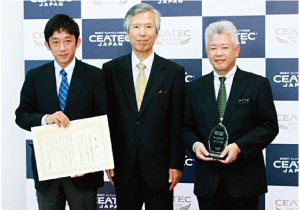"KeePace™," a personalized electric walking assist car, was given a runner up award in the Smart Key Technologies Category of the "CEATEC (Combined Exhibition of Advanced Technologies) AWARD 2012" (Fig. 9) .
We were surprised by the positive review given by the judging committee, "With the ageing of the population, this technology is very practical and has great social significance." As we look around, we find many care robots "giving support to the disabled" or "easing the load off the caregivers", but we don't find many robots like KeePace™ to "keep people from becoming disabled." As our society becomes aged, we expect KeePace™ to keep people from being bed-bound or dependent on wheelchairs, and prolong the period of independent mobility.
Meanwhile, we face a load of problems for the actual usage of the unit. Our immediate challenge is to ensure "safety" and "reliability." The unit must be made lighter so that senior citizens and walking-impaired individuals can handle it with ease. We will continue to work on its development, so that we can put the "stand still" technology of MURATA BOY to practical use while clearing hurdles one by one.

Fig. 9 CEATEC AWARD 2012 Award Ceremony
Photo on the left: Murata Manufacturing Co., Ltd. commercialization staff member
On the right: KOWA CO., LTD. Director: Development Division General Manager